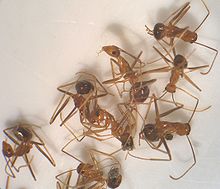Yellow crazy ant
| Yellow crazy ant | |
|---|---|
 |
|
| Scientific classification | |
| Kingdom: | Animalia |
| Phylum: | Arthropoda |
| Class: | Insecta |
| Order: | Hymenoptera |
| Family: | Formicidae |
| Genus: | Anoplolepis |
| Species: | A. gracilipes |
| Binomial name | |
|
Anoplolepis gracilipes F. Smith, 1857 |
|
| Synonyms | |
|
Formica longipes, |
|
Formica longipes,
Plagiolepis longipes,
Anoplolepis longipes
The yellow crazy ant (Anoplolepis gracilipes) is a species of ant, introduced accidentally to northern Australia and Christmas Island in the Indian Ocean, that has caused ecological damage in both locations and now found in the northern suburbs of Brisbane. It is colloquially called "crazy" because of its erratic movements when disturbed. Its long legs and antennae make it one of the largest invasive ant species in the world.
Like several other invasive ants, such as the red imported fire ant (Solenopsis invicta), the big-headed ant (Pheidole megacephala), the little fire ant (Wasmannia auropunctata), and the Argentine ant (Linepithema humile), this is a "tramp ant", a species that easily becomes established and dominant in new habitat due to traits such as aggression toward other ant species, little aggression toward members of its own species, efficient recruitment, and large colony size. Also known as the long-legged ant or Maldive ant, it is on a list of "One Hundred of the World's Worst Invasive Species" formulated by the International Union for Conservation of Nature (IUCN). It has invaded ecosystems from Hawaii to Seychelles, and formed supercolonies on Christmas Island in the Indian Ocean.
Anoplolepis gracilipes is a relatively large, yellow to orange ant with long legs, large eyes and extremely long antennal scapes.
Although A. gracilipes is the only invasive species in the genus Anoplolepis, there are several other genera that it can be mistaken for. Both Leptomyrmex and Oecophylla can be confused with Anoplolepis because of their similar sizes and very long limbs. Anoplolepis can be distinguished from Leptomyrmex by the presence of an acidopore. Anoplolepis can be distinguished from Oecophylla by the more compact petiole. Although both of these genera occur in the Pacific, neither contain any invasive species.
...
Wikipedia
